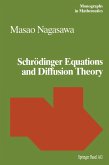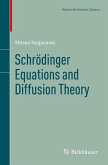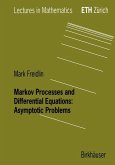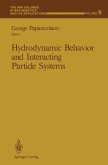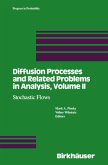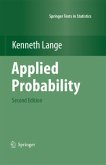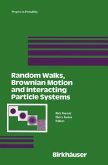M. Nagasawa
Schrödinger Equations and Diffusion Theory
M. Nagasawa
Schrödinger Equations and Diffusion Theory
- Broschiertes Buch
- Merkliste
- Auf die Merkliste
- Bewerten Bewerten
- Teilen
- Produkt teilen
- Produkterinnerung
- Produkterinnerung
Schrödinger Equations and Diffusion Theory addresses the question "What is the Schrödinger equation?" in terms of diffusion processes, and shows that the Schrödinger equation and diffusion equations in duality are equivalent. In turn, Schrödinger's conjecture of 1931 is solved. The theory of diffusion processes for the Schrödinger equation tell us that we must go further into the theory of systems of (infinitely) many interacting quantum (diffusion) particles. The method of relative entropy and the theory of transformations enable us to construct severely singular diffusion processes which…mehr
Andere Kunden interessierten sich auch für
![Schrödinger Equations and Diffusion Theory Schrödinger Equations and Diffusion Theory]() M. NagasawaSchrödinger Equations and Diffusion Theory41,99 €
M. NagasawaSchrödinger Equations and Diffusion Theory41,99 €![Schrödinger Equations and Diffusion Theory Schrödinger Equations and Diffusion Theory]() Masao NagasawaSchrödinger Equations and Diffusion Theory58,99 €
Masao NagasawaSchrödinger Equations and Diffusion Theory58,99 €![Markov Processes and Differential Equations Markov Processes and Differential Equations]() Mark I. FreidlinMarkov Processes and Differential Equations37,99 €
Mark I. FreidlinMarkov Processes and Differential Equations37,99 €![Hydrodynamic Behavior and Interacting Particle Systems Hydrodynamic Behavior and Interacting Particle Systems]() Hydrodynamic Behavior and Interacting Particle Systems41,99 €
Hydrodynamic Behavior and Interacting Particle Systems41,99 €![Diffusion Processes and Related Problems in Analysis, Volume II Diffusion Processes and Related Problems in Analysis, Volume II]() Diffusion Processes and Related Problems in Analysis, Volume II41,99 €
Diffusion Processes and Related Problems in Analysis, Volume II41,99 €![Applied Probability Applied Probability]() Kenneth LangeApplied Probability108,99 €
Kenneth LangeApplied Probability108,99 €![Random Walks, Brownian Motion, and Interacting Particle Systems Random Walks, Brownian Motion, and Interacting Particle Systems]() Durrett, Rick, Kesten, Harry (Hrsg.)Random Walks, Brownian Motion, and Interacting Particle Systems81,99 €
Durrett, Rick, Kesten, Harry (Hrsg.)Random Walks, Brownian Motion, and Interacting Particle Systems81,99 €-
-
-
Schrödinger Equations and Diffusion Theory addresses the question "What is the Schrödinger equation?" in terms of diffusion processes, and shows that the Schrödinger equation and diffusion equations in duality are equivalent. In turn, Schrödinger's conjecture of 1931 is solved. The theory of diffusion processes for the Schrödinger equation tell us that we must go further into the theory of systems of (infinitely) many interacting quantum (diffusion) particles.
The method of relative entropy and the theory of transformations enable us to construct severely singular diffusion processes which appear to be equivalent to Schrödinger equations.
The theory of large deviations and the propagation of chaos of interacting diffusion particles reveal the statistical mechanical nature of the Schrödinger equation, namely, quantum mechanics.
The text is practically self-contained and requires only an elementary knowledge of probability theory at the graduate level.
Hinweis: Dieser Artikel kann nur an eine deutsche Lieferadresse ausgeliefert werden.
The method of relative entropy and the theory of transformations enable us to construct severely singular diffusion processes which appear to be equivalent to Schrödinger equations.
The theory of large deviations and the propagation of chaos of interacting diffusion particles reveal the statistical mechanical nature of the Schrödinger equation, namely, quantum mechanics.
The text is practically self-contained and requires only an elementary knowledge of probability theory at the graduate level.
Hinweis: Dieser Artikel kann nur an eine deutsche Lieferadresse ausgeliefert werden.
Produktdetails
- Produktdetails
- Monographs in Mathematics 86
- Verlag: Birkhäuser / Birkhäuser Basel / Springer, Basel
- Artikelnr. des Verlages: 978-3-0348-9684-9
- Softcover reprint of the original 1st ed. 1993
- Seitenzahl: 340
- Erscheinungstermin: 27. September 2012
- Englisch
- Abmessung: 235mm x 155mm x 19mm
- Gewicht: 517g
- ISBN-13: 9783034896849
- ISBN-10: 3034896840
- Artikelnr.: 41321878
- Herstellerkennzeichnung Die Herstellerinformationen sind derzeit nicht verfügbar.
- Monographs in Mathematics 86
- Verlag: Birkhäuser / Birkhäuser Basel / Springer, Basel
- Artikelnr. des Verlages: 978-3-0348-9684-9
- Softcover reprint of the original 1st ed. 1993
- Seitenzahl: 340
- Erscheinungstermin: 27. September 2012
- Englisch
- Abmessung: 235mm x 155mm x 19mm
- Gewicht: 517g
- ISBN-13: 9783034896849
- ISBN-10: 3034896840
- Artikelnr.: 41321878
- Herstellerkennzeichnung Die Herstellerinformationen sind derzeit nicht verfügbar.
I Introduction and Motivation.- 1.1 Quantization.- 1.2 Schrödinger Equation.- 1.3 Quantum Mechanics and Diffusion Processes.- 1.4 Equivalence of Schrödinger and Diffusion Equations.- 1.5 Time Reversal and Duality.- 1.6 QED and Quantum Field Theory.- 1.7 What is the Schrödinger Equation.- 1.8 Mathematical Contents.- II Diffusion Processes and their Transformations.- 2.1 Time Homogeneous Diffusion Processes.- 2.2 Time Inhomogeneous Diffusion Processes.- 2.3 Brownian Motions.- 2.4 Stochastic Differential Equations.- 2.5 Transformation by a Multiplicative Functional.- 2.6 Feynman-Kac Formula.- 2.7 Kac's Semi-Group and its Renormalization.- 2.8 Time Change.- 2.9 Dirichlet Problem.- 2.10 Feller's One-Dimensional Diffusion Processes.- 2.11 Feller's Test.- III Duality and Time Reversal of Diffusion Processes.- 3.1 Kolmogoroff's Duality.- 3.2 Time Reversal of Diffusion Processes.- 3.3 Duality of Time-Inhomogeneous Diffusion Processes.- 3.4 Schrödinger's and Kolmogoroff s Representations.- 3.5 Some Remarks.- IV Equivalence of Diffusion and Schrödinger Equations.- 4.1 Change of Variable Formulae.- 4.2 Equivalence Theorem.- 4.3 Discussion of the Non-Linear Dependence.- 4.4 A Solution to Schrödinger's Conjecture.- 4.5 A Unified Theory.- 4.6 On Quantization.- 4.7 As a Diffusion Theory.- 4.8 Principle of Superposition.- 4.9 Remarks.- V Variational Principle.- 5.1 Problem Setting in p-Representation.- 5.2 Csiszar's Projection Theorem.- 5.3 Reference Processes.- 5.4 Diffusion Processes in Schrödinger's Representation.- 5.5 Weak Fundamental Solutions.- 5.6 An Entropy Characterization of the Markov Property.- 5.6 Remarks.- VI Diffusion Processes in q-Representation.- 6.1 A Multiplicative Functional.- 6.2 Flows of Distribution Densities.- 6.3 Discussions on theq-Representation.- 6.4 What is the Feynman Integral.- 6.5 A Remark on Kac's Semi-Group.- 6.6 A Typical Case.- 6.7 Hydrogen Atom.- 6.8 A Remark on {?a,?b}.- VII Segregation of a Population.- 7.1 Introduction.- 7.2 Harmonic Oscillator.- 7.3 Segregation of a Finite-System of Particles.- 7.4 A Formulation of the Propagation of Chaos.- 7.5 The Propagation of Chaos.- 7.6 Skorokhod Problem with Singular Drift.- 7.7 A Limit Theorem.- 7.8 A Proof of Theorem 7.1.- 7.9 Schrödinger Equations with Singular Potentials.- VIII The Schrödinger Equation can be a Boltzmann Equation.- 8.1 Large Deviations.- 8.2 The Propagation of Chaos in Terms of Large Deviations.- 8.3 Statistical Mechanics for Schrödinger Equations.- 8.4 Some Comments.- IX Applications of the Statistical Model for Schrödinger Equation.- 9.1 Segregation of a Monkey Population.- 9.2 An Eigenvalue Problem.- 9.3 Septation of Escherichia Coli.- 9.4 The Mass Spectrum of Mesons.- 9.5 Titius-Bode Law.- X Relative Entropy and Csiszar's Projection.- 10.1 Relative Entropy.- 10.2 Csiszar's Projection.- 10.3 Exponential Families and Marginal Distributions.- XI Large Deviations.- 11.1 Lemmas.- 11.2 Large Deviations of Empirical Distributions.- XII Non-Linearity Induced by the Branching Property.- 12.1 Branching Property.- 12.2 Non-Linear Equations of Branching Processes.- 12.3 Quasi-Linear Parabolic Equations.- 12.4 Branching Markov Processes with Non-Linear Drift.- 12.5 Revival of a Markov Process.- 12.6 Construction of Branching Markov Processes.- Appendix:.- a.1 Fényes' "Equation of Motion" of Probability Densities.- a.2 Stochastic Mechanics.- a.3 Segregation of a Population.- a.4 Euclidean Quantum Mechanics.- a.5 Remarks.- a.6 Bohmian Mechanics.- References.
I Introduction and Motivation.- 1.1 Quantization.- 1.2 Schrödinger Equation.- 1.3 Quantum Mechanics and Diffusion Processes.- 1.4 Equivalence of Schrödinger and Diffusion Equations.- 1.5 Time Reversal and Duality.- 1.6 QED and Quantum Field Theory.- 1.7 What is the Schrödinger Equation.- 1.8 Mathematical Contents.- II Diffusion Processes and their Transformations.- 2.1 Time Homogeneous Diffusion Processes.- 2.2 Time Inhomogeneous Diffusion Processes.- 2.3 Brownian Motions.- 2.4 Stochastic Differential Equations.- 2.5 Transformation by a Multiplicative Functional.- 2.6 Feynman-Kac Formula.- 2.7 Kac's Semi-Group and its Renormalization.- 2.8 Time Change.- 2.9 Dirichlet Problem.- 2.10 Feller's One-Dimensional Diffusion Processes.- 2.11 Feller's Test.- III Duality and Time Reversal of Diffusion Processes.- 3.1 Kolmogoroff's Duality.- 3.2 Time Reversal of Diffusion Processes.- 3.3 Duality of Time-Inhomogeneous Diffusion Processes.- 3.4 Schrödinger's and Kolmogoroff s Representations.-
I Introduction and Motivation.- 1.1 Quantization.- 1.2 Schrödinger Equation.- 1.3 Quantum Mechanics and Diffusion Processes.- 1.4 Equivalence of Schrödinger and Diffusion Equations.- 1.5 Time Reversal and Duality.- 1.6 QED and Quantum Field Theory.- 1.7 What is the Schrödinger Equation.- 1.8 Mathematical Contents.- II Diffusion Processes and their Transformations.- 2.1 Time Homogeneous Diffusion Processes.- 2.2 Time Inhomogeneous Diffusion Processes.- 2.3 Brownian Motions.- 2.4 Stochastic Differential Equations.- 2.5 Transformation by a Multiplicative Functional.- 2.6 Feynman-Kac Formula.- 2.7 Kac's Semi-Group and its Renormalization.- 2.8 Time Change.- 2.9 Dirichlet Problem.- 2.10 Feller's One-Dimensional Diffusion Processes.- 2.11 Feller's Test.- III Duality and Time Reversal of Diffusion Processes.- 3.1 Kolmogoroff's Duality.- 3.2 Time Reversal of Diffusion Processes.- 3.3 Duality of Time-Inhomogeneous Diffusion Processes.- 3.4 Schrödinger's and Kolmogoroff s Representations.- 3.5 Some Remarks.- IV Equivalence of Diffusion and Schrödinger Equations.- 4.1 Change of Variable Formulae.- 4.2 Equivalence Theorem.- 4.3 Discussion of the Non-Linear Dependence.- 4.4 A Solution to Schrödinger's Conjecture.- 4.5 A Unified Theory.- 4.6 On Quantization.- 4.7 As a Diffusion Theory.- 4.8 Principle of Superposition.- 4.9 Remarks.- V Variational Principle.- 5.1 Problem Setting in p-Representation.- 5.2 Csiszar's Projection Theorem.- 5.3 Reference Processes.- 5.4 Diffusion Processes in Schrödinger's Representation.- 5.5 Weak Fundamental Solutions.- 5.6 An Entropy Characterization of the Markov Property.- 5.6 Remarks.- VI Diffusion Processes in q-Representation.- 6.1 A Multiplicative Functional.- 6.2 Flows of Distribution Densities.- 6.3 Discussions on theq-Representation.- 6.4 What is the Feynman Integral.- 6.5 A Remark on Kac's Semi-Group.- 6.6 A Typical Case.- 6.7 Hydrogen Atom.- 6.8 A Remark on {?a,?b}.- VII Segregation of a Population.- 7.1 Introduction.- 7.2 Harmonic Oscillator.- 7.3 Segregation of a Finite-System of Particles.- 7.4 A Formulation of the Propagation of Chaos.- 7.5 The Propagation of Chaos.- 7.6 Skorokhod Problem with Singular Drift.- 7.7 A Limit Theorem.- 7.8 A Proof of Theorem 7.1.- 7.9 Schrödinger Equations with Singular Potentials.- VIII The Schrödinger Equation can be a Boltzmann Equation.- 8.1 Large Deviations.- 8.2 The Propagation of Chaos in Terms of Large Deviations.- 8.3 Statistical Mechanics for Schrödinger Equations.- 8.4 Some Comments.- IX Applications of the Statistical Model for Schrödinger Equation.- 9.1 Segregation of a Monkey Population.- 9.2 An Eigenvalue Problem.- 9.3 Septation of Escherichia Coli.- 9.4 The Mass Spectrum of Mesons.- 9.5 Titius-Bode Law.- X Relative Entropy and Csiszar's Projection.- 10.1 Relative Entropy.- 10.2 Csiszar's Projection.- 10.3 Exponential Families and Marginal Distributions.- XI Large Deviations.- 11.1 Lemmas.- 11.2 Large Deviations of Empirical Distributions.- XII Non-Linearity Induced by the Branching Property.- 12.1 Branching Property.- 12.2 Non-Linear Equations of Branching Processes.- 12.3 Quasi-Linear Parabolic Equations.- 12.4 Branching Markov Processes with Non-Linear Drift.- 12.5 Revival of a Markov Process.- 12.6 Construction of Branching Markov Processes.- Appendix:.- a.1 Fényes' "Equation of Motion" of Probability Densities.- a.2 Stochastic Mechanics.- a.3 Segregation of a Population.- a.4 Euclidean Quantum Mechanics.- a.5 Remarks.- a.6 Bohmian Mechanics.- References.
I Introduction and Motivation.- 1.1 Quantization.- 1.2 Schrödinger Equation.- 1.3 Quantum Mechanics and Diffusion Processes.- 1.4 Equivalence of Schrödinger and Diffusion Equations.- 1.5 Time Reversal and Duality.- 1.6 QED and Quantum Field Theory.- 1.7 What is the Schrödinger Equation.- 1.8 Mathematical Contents.- II Diffusion Processes and their Transformations.- 2.1 Time Homogeneous Diffusion Processes.- 2.2 Time Inhomogeneous Diffusion Processes.- 2.3 Brownian Motions.- 2.4 Stochastic Differential Equations.- 2.5 Transformation by a Multiplicative Functional.- 2.6 Feynman-Kac Formula.- 2.7 Kac's Semi-Group and its Renormalization.- 2.8 Time Change.- 2.9 Dirichlet Problem.- 2.10 Feller's One-Dimensional Diffusion Processes.- 2.11 Feller's Test.- III Duality and Time Reversal of Diffusion Processes.- 3.1 Kolmogoroff's Duality.- 3.2 Time Reversal of Diffusion Processes.- 3.3 Duality of Time-Inhomogeneous Diffusion Processes.- 3.4 Schrödinger's and Kolmogoroff s Representations.-


